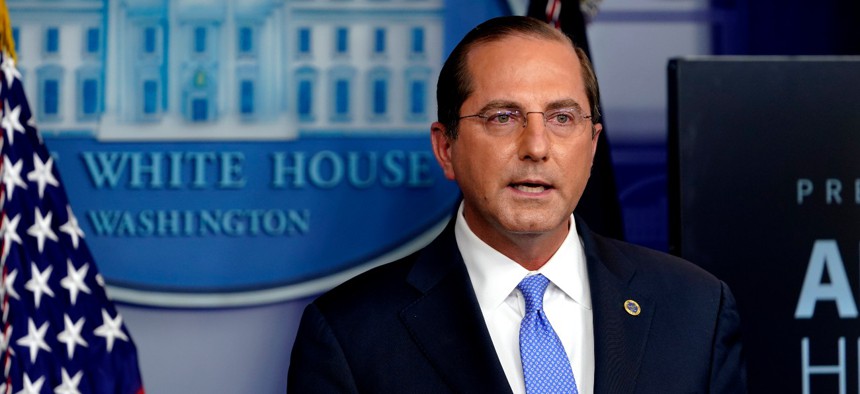
HHS Secretary Alex Azar speaks during a news conference on Nov. 20. Azar said the new HHS policy will help citizens provide feedback on new rules. Susan Walsh/AP
New HHS Policy Requires All Information to Be Released for Upcoming Rules
Experts criticize and question its purpose as the Trump administration winds down.
The Health and Human Services Department implemented a new policy on Monday that requires all information associated with new rules to be made public in an attempt to be more transparent.
The policy requires “all assumptions, working papers, models, and other information used as part of any impact analysis (e.g., economic, actuarial) associated with a rule (including the setting of payment rates) or demonstration project” to be posted on HHS’ website when the results of the analysis are publicly released, with certain exceptions. HHS said the purpose is to provide the public with more insight into the regulations the government seeks to impose. However, several experts are skeptical of the merits of this policy change during the Trump administration's last few weeks in office.
“The department's regulations and demonstration projects involving federal health care programs, the Affordable Care Act; the Food, Drug, and Cosmetic Act; or the Public Health Service Act are amongst the most economically significant actions undertaken by any federal agency,” wrote HHS Secretary Alex Azar, in the notice posted in the Federal Register. “The department believes that its decision-making ought to be as transparent as appropriate to better enable the citizenry to comment on its proposed rules and demonstration projects.”
HHS said the new policy won’t hinder its ability to respond to the novel coronavirus pandemic and will not affect the work or independence of its technical experts. The policy is not retroactive, but the department said it would consider requests on a case-by-case basis to release information on rulemaking before November 30.
However, some experts said the policy may have ulterior motives.
“It weaponizes seemingly benign transparency requirements for a deregulatory effect, by limiting the type of information the agency can use and thereby limiting agency discretion,” Margaret Foster Riley, law professor at the University of Virginia who specializes in public health law among other areas, told Government Executive. “It is particularly problematic when, as in health care, confidentiality rules limit publication of data.”
The policy has a “similar effect” to the Environmental Protection Agency’s proposed rule to combat “secret science,” which requires scientists to disclose all of their data before the EPA will consider their study’s findings, she said. The rule is expected to be finalized before Inauguration Day, according to ProPublica.
Genna Reed, lead science and policy analyst in the Center for Science and Democracy at the Union of Concerned Scientists, also said the policy is “related” to the EPA rule, “but is slightly different in that it’s not as specific; it’s also not a rule,” therefore she believes it will be “significantly easier” for the Biden administration to get rid of it.
“Under the Trump administration we have seen attempts to undermine [and] politicize science at the agencies and there are overt instances of this with pulling grant funding for important scientific projects or reducing scientific capacity at the agencies,” she told Government Executive. “There are also more subtle changes that are happening in the regulatory process, like these types of changes to the ways in which agencies must release and publicize data to make it easier for industry stakeholders to basically change the ways agencies can rely on science to make decisions.”
James Goodwin, senior policy analyst at the Center for Progressive Reform who specializes in regulations, pointed to other recent HHS policies and proposed rules meant to “gum up the works” for the Biden administration, as Government Executive previously reported. According to the Office of Information and Regulatory Affairs’ tracker, there are 147 regulatory actions in various stages of the rulemaking process, the majority of which are from HHS and EPA.
“There is no question that is meant as a political landmine that they’re leaving behind,” Goodwin said, in reference to the new policy.
Moreover, even if all the information is released, “that doesn’t necessarily mean that these analyses are going to be transparent,” Goodwin stated. “They are dense, difficult documents to read and that’s sort of a different kind of transparency.”







